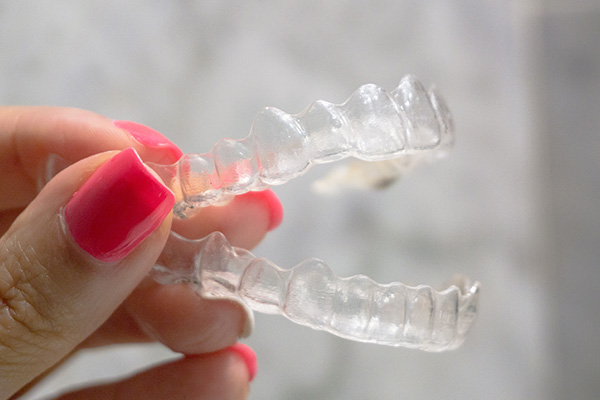How Does a Dental Bridge Affect Invisalign?

Invisalign® is an effective teeth-straightening method for many patients. Regardless of your situation, you should be able to benefit from these clear aligners. If you have crooked, misshapen or crowded teeth, this could be the right process for you. Even if you have had other procedures to replace missing teeth, consider this method.
The advantages of Invisalign
People who choose these clear aligners over braces enjoy the benefits of this treatment. First, aligners are virtually invisible, so the self-conscious patient should not have to worry about other people seeing the apparatus. Also, treatment with aligners is often shorter than with traditional metal braces. The trays are also removable, making them manageable to care for and maintain. Plus, the aligners are not likely to cut the mouth or cause sores like braces sometimes do.
How a bridge works
While Invisalign straightens teeth, bridges replace missing ones. Patients usually choose this method if one or two teeth are no longer in place. The bridge consists of artificial teeth, a metal framework and two crowns. The crowns go over existing teeth and serve as an anchor for the artificial teeth. The bridge is fixed and should only be removed by the dentist.
Consulting with the dentist
Patients who desire to start Invisalign treatment should first meet with their dentist. This professional will make sure this method makes the most sense and that the patient is a good candidate. The dentist will review the person’s dental history. The dentist also takes X-rays and makes impressions of the mouth and teeth. The dentist will also talk to the patient about how their dental bridge will affect the treatment.
Move the teeth, not the bridge
Because the bridge is cemented in place, it will not move with the rest of the teeth. The aligner will cover the artificial teeth as it does the natural teeth. The natural teeth will still adjust properly. The aligners will not have any effect on the bridge. If the patient wants the teeth in the bridge to move, a dentist will have to remove the bridge and put in another one when the treatment is over.
Make the right choice
Patients with bridges should be thoughtful when deciding whether to get Invisalign treatment. The dentist will explain the process and how it will affect the bridge. Patients who are fine with the idea of taking out the bridge during the treatment should begin immediately. Because treatment time is usually between 12 and 18 months, the patient can get a straight smile and then return to doing bridgework.
Effective for most situations
The health and appearance of your teeth are important aspects of your well-being. Invisalign clear aligners are a good way to straighten teeth, even if you have other dental appliances in your mouth. If you are worried about how your dental bridge will impact your aligner trays, speak to your dentist. Do not let other dental issues get in the way of your smile makeover. Schedule an appointment today so you can get started.
Request an appointment here: https://thechesterfielddentist.com or call Chesterfield Dentist at (804) 412-0867 for an appointment in our Chester office.
Check out what others are saying about our services on Yelp: Read our Yelp reviews.
Recent Posts
Sleep apnea is a serious sleep disorder that affects millions of individuals worldwide. It occurs when breathing repeatedly stops and starts during sleep, disrupting rest and potentially causing long-term health consequences. Many people are unaware that a general dentist plays a key role in diagnosing and managing sleep apnea, particularly with non-invasive treatment solutions. By…
Dental restorations can improve overall health by decreasing the chances of infection, decay, and issues caused by broken or misaligned teeth. These treatments range from removing teeth, replacing tooth structures that have decayed, and correcting the patient’s overall bite to improving eating and drinking.A restoration may be performed for cosmetic or health-related reasons, but even…
Crowns are commonly used in dental restorations. A crown is a cap shaped like a tooth but hollow in the middle. It fits over a natural tooth that has to be prepared first. Depending on the issue it is correcting, a crown can be used by itself or as a component of another restoration technique.Teeth…
A broken tooth can affect both oral health and confidence. Whether caused by biting into something hard, an accident, or underlying decay, prompt dental care is essential to prevent further damage and restore normal function. Fortunately, modern dentistry provides several reliable treatments that repair structural damage and rebuild a natural-looking smile. A cosmetic, family, or…


